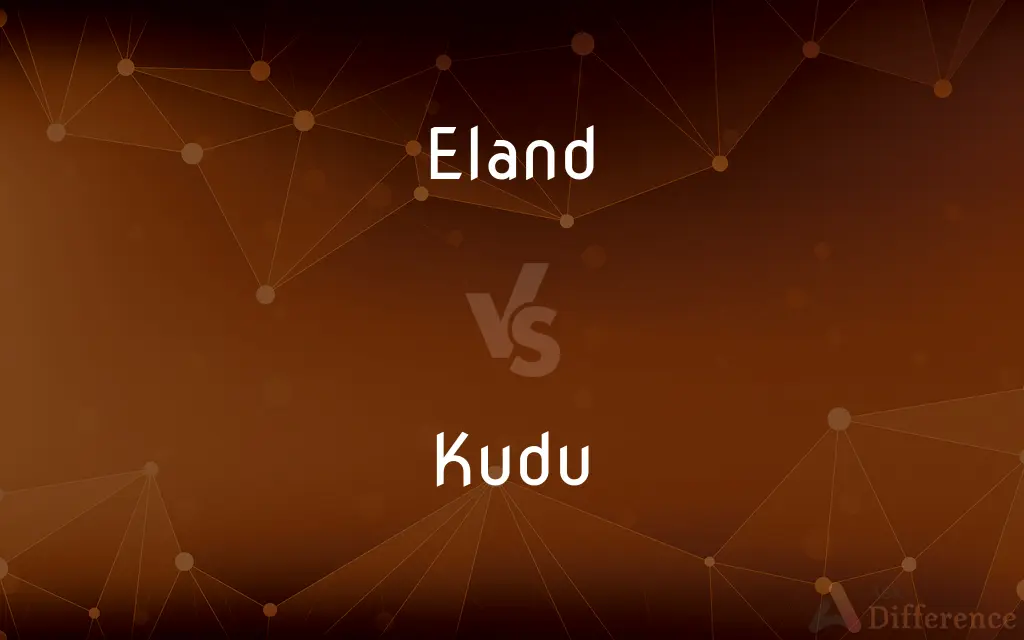Eland vs. Kudu — What's the Difference?
Edited by Tayyaba Rehman — By Urooj Arif — Updated on April 30, 2024
Eland are the largest of antelopes, weighing up to 900 kg, while kudus are smaller, with two species that have distinct horn and body sizes.

Difference Between Eland and Kudu
Table of Contents
ADVERTISEMENT
Key Differences
Eland, as the largest antelopes, are significantly bulkier and can weigh between 400 and 900 kg, characterized by their robust bodies. On the other hand, kudus are more slender and lighter, with the greater kudu weighing up to 315 kg and the lesser kudu around 108 kg. Both animals are recognized for their impressive horns, but their body mass shows a clear distinction.
While elands are generally less colorful, featuring a tan or fawn-colored coat with faint striping, kudus have more distinct markings. Kudus display a striking coat that includes white stripes and spots against a darker gray or brown background, making them particularly noticeable in their habitats.
Elands are found in both East and Southern Africa, thriving in a variety of habitats including grasslands, mountains, and woodlands. Kudus, on the other hand, are more specifically adapted to wooded areas. This habitat preference influences their behavior and feeding patterns, with kudus being more selective browsers compared to the more versatile eland.
Regarding social structure, elands are unique among antelopes for their flexible group behaviors. They can be found in both large herds and solitary conditions. Kudus tend to be more consistently social, typically seen in small family groups, particularly the females and young, while males are often solitary.
Elands are capable of a remarkable feat for their size — they can jump up to 2.5 meters from a standstill. This ability contrasts with kudus, who are also agile but more likely to rely on running rather than jumping to escape predators.
ADVERTISEMENT
Comparison Chart
Size
Weighs 400-900 kg
Greater kudu up to 315 kg; Lesser kudu up to 108 kg
Coat Color
Tan or fawn with faint striping
Darker gray or brown with distinct white stripes and spots
Habitat
Grasslands, mountains, woodlands
Predominantly wooded areas
Social Structure
Flexible, can be solitary or in large herds
Small family groups or solitary males
Jumping Ability
Can jump up to 2.5 meters high
More likely to run than jump
Compare with Definitions
Eland
They exhibit a high level of social flexibility, living solitarily or in herds.
The solitary eland has separated from its herd during the dry season.
Kudu
Typically found in wooded or bushy areas where they use camouflage to evade predators.
Kudus use their striped coats as camouflage against the bushy landscape.
Eland
Elands are significant in cultural symbolism and mythology in various African cultures.
In local folklore, the eland is often depicted as a symbol of peace and prosperity.
Kudu
Greater and lesser kudus differ significantly in size and weight.
The lesser kudu is noticeably smaller than its greater counterpart.
Eland
Elands are adaptable to various habitats, from flat savannas to mountainous terrains.
The adaptability of elands makes them resilient to changes in their environment.
Kudu
A genus of antelope known for their long, spiral horns and striking body markings.
A male kudu's horns can grow long enough to be impressive sights.
Eland
A large African antelope with a tan or fawn coat, often used for meat and leather.
The eland at the reserve seemed unbothered by our presence.
Kudu
Kudus are primarily browsers, feeding on leaves and branches.
Kudus at the zoo are fed a diet rich in foliage to mimic their natural habits.
Eland
Known for their ability to jump high fences despite their size.
Farmers sometimes build taller fences to prevent elands from entering crop areas.
Kudu
Their social behavior is characterized by smaller, more stable family groups.
Female kudus and their offspring form tight-knit groups for better protection.
Eland
Either of two large African antelopes (Taurotragus oryx or T. derbianus) having a light brown or grayish coat, spirally twisted horns, and in the male a large dewlap.
Kudu
Either of two large African antelopes (Tragelaphus strepsiceros or T. imberbis) having a brownish or grayish coat with white vertical stripes and, in the male, long, spirally curved horns.
Eland
A genus of large South African antelope (Taurotragus), valued both for its hide and flesh.
Kudu
A large, striped, African antelope of the species Tragelaphus imberbis (the lesser kudu) or Tragelaphus strepsiceros (the greater kudu).
Eland
A species of large South African antelope (Oreas canna). It is valued both for its hide and flesh, and is rapidly disappearing in the settled districts; - called also Cape elk.
Kudu
See Koodoo.
Eland
The elk or moose.
Kudu
Either of two spiral-horned antelopes of the African bush
Common Curiosities
How do the diets of elands and kudus differ?
Elands have a more varied diet that can include grasses and leaves, making them both browsers and grazers, while kudus are primarily browsers, focusing on leaves and branches.
How long do elands and kudus live?
Elands can live up to 15-20 years in the wild, while kudus generally have a slightly shorter lifespan of around 12-15 years.
What are the key physical differences between elands and kudus?
Elands are larger with a more robust build and less distinct markings, whereas kudus are smaller with vivid white stripes and spots.
What role do elands play in their ecosystem?
Elands help in seed dispersal through their feces and contribute to the control of vegetation, thereby maintaining the ecological balance.
What predators do elands and kudus face?
Common predators include lions, leopards, and hyenas, with the larger size of elands sometimes deterring the smaller predators that more frequently target kudus.
What impact does climate change have on elands and kudus?
Climate change affects water and food availability, which can alter their habitats and potentially lead to conflicts with humans as these species search for resources.
What are the conservation statuses of elands and kudus?
Both species face threats from habitat loss and hunting; however, conservation efforts vary by region and species, with some eland species being less threatened than kudus.
How do elands and kudus respond to environmental changes?
Elands are quite adaptable and can move to different habitats if necessary, whereas kudus are more dependent on the availability of cover and may suffer more from deforestation.
Are elands or kudus ever kept in captivity, such as in zoos?
Yes, both elands and kudus are commonly found in zoos around the world where they are important for educational and conservation purposes.
How do the horn structures of elands compare to those of kudus?
Both have spiraled horns, but kudu horns are typically longer and more twisted, while eland horns are shorter and stouter.
Can elands and kudus interbreed?
No, they are different genera and cannot interbreed; elands belong to the genus Taurotragus, and kudus to the genus Tragelaphus.
How do the reproductive habits of elands differ from those of kudus?
Elands can breed year-round, depending on environmental conditions, while kudus have more defined breeding seasons influenced by their specific habitat.
What cultural significance do elands and kudus have in Africa?
Both are featured in various African folklore and traditions, often symbolizing strength and agility, with elands particularly revered in some cultures for their perceived spiritual significance.
How visible are elands and kudus in their natural environments?
Elands, due to their size and less vibrant coloring, can be less conspicuous in open areas, while kudus' stripes help them blend effectively in wooded or bushy environments.
What are some notable behaviors unique to kudus?
Kudus are known for their impressive leaping ability and can jump over obstacles up to 2.5 meters high, often used as a defense mechanism.
What measures are being taken to conserve elands and kudus?
Conservation measures include habitat protection, anti-poaching efforts, and breeding programs, particularly in wildlife reserves and national parks.
Share Your Discovery

Previous Comparison
Legend vs. Truth
Next Comparison
Greenstone vs. SerpentineAuthor Spotlight
Written by
Urooj ArifUrooj is a skilled content writer at Ask Difference, known for her exceptional ability to simplify complex topics into engaging and informative content. With a passion for research and a flair for clear, concise writing, she consistently delivers articles that resonate with our diverse audience.
Edited by
Tayyaba RehmanTayyaba Rehman is a distinguished writer, currently serving as a primary contributor to askdifference.com. As a researcher in semantics and etymology, Tayyaba's passion for the complexity of languages and their distinctions has found a perfect home on the platform. Tayyaba delves into the intricacies of language, distinguishing between commonly confused words and phrases, thereby providing clarity for readers worldwide.
















































